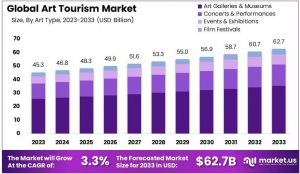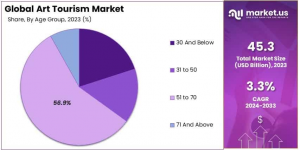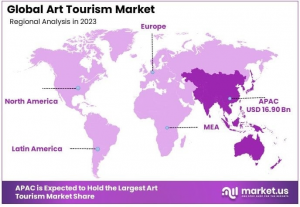Art Tourism Market to Witness Steady Growth with a 3.3% CAGR Reaching USD 62.7 Billion by 2033
Art Tourism Market size is expected to be worth around USD 62.7 Bn by 2033, from USD 45.3 Bn in 2023, growing at a CAGR of 3.3% during the forecast period.
In 2023, Asia Pacific dominated with 37.3%, valued at USD 16.90 Billion, driven by rising cultural tourism.”
NEW YORK, NY, UNITED STATES, January 24, 2025 /EINPresswire.com/ -- Report Overview— Tajammul Pangarkar
According to a report by Market.us, the Global Art Tourism Market is anticipated to surge to USD 62.7 Billion by 2033, up from USD 45.3 Billion in 2023, marking a robust compound annual growth rate (CAGR) of 3.3% over the forecast period from 2024 to 2033.
Art tourism, which involves travel experiences centered around the exploration of art, culture, and creativity, encompasses activities such as visiting museums, galleries, art festivals, and historical landmarks. This market's expansion is driven by the escalating global interest in immersive and culturally rich travel experiences, particularly among higher-income demographics seeking destinations with unique artistic heritage and vibrant cultural scenes.
Regions like Asia Pacific dominate the market, fueled by their extensive cultural heritage, substantial investments in art infrastructure, and a rapidly growing middle class with increasing disposable income. North America and Europe also hold significant market shares, supported by their well-established art institutions and iconic cultural events that attract millions of visitors annually.
Additionally, the post-pandemic recovery has reignited global travel and heightened interest in cultural and artistic activities, further propelling the growth of the art tourism sector. The integration of technology, such as augmented reality (AR) and virtual reality (VR), in enhancing art tourism experiences, along with the availability of tailored art-centric travel packages, government initiatives promoting cultural tourism, and the rise of digital platforms showcasing regional art, collectively contribute to the dynamic and competitive landscape of the art tourism market. As cities and regions continue to invest in art galleries, museums, and host biennials and art fairs, the market remains poised for sustained growth and innovation.
➥ Need More Insights? Speak with Our Experts or Request a Full Report Here - https://market.us/report/art-tourism-market/request-sample/
Key Takeaways
- The Art Tourism Market, valued at USD 45.3 Billion in 2023, is projected to escalate to USD 62.7 Billion by 2033, exhibiting a steady CAGR of 3.3%, underscoring the sustained interest and investment in culturally immersive travel experiences globally.
- In 2023, the Art Galleries & Museums segment dominated the art type category with a substantial 56.5% market share, reflecting the enduring appeal and educational value of visual arts institutions among tourists.
- Offline booking channels led the market in 2023 with a commanding 68.2% share, indicating a prevailing preference for personalized service and direct interaction in planning complex art-focused travel itineraries.
- The age demographic of 51 to 70 years emerged as the largest segment in 2023, accounting for 56.9% of the market, driven by this group's higher disposable income and keen interest in cultural enrichment through art tourism.
- Asia Pacific region held the foremost position in the market with a 37.3% share valued at USD 16.90 Billion in 2023, propelled by rising cultural tourism, substantial investments in art infrastructure, and a burgeoning middle class with increasing disposable income.
Regional Analysis
Asia Pacific stands out as the leading region in the Global Art Tourism Market, commanding a significant 37.3% market share valued at USD 16.90 Billion in 2023. This dominance is primarily driven by the region’s rich and diverse cultural heritage, which attracts a vast number of art enthusiasts and tourists seeking immersive cultural experiences. Countries such as China, Japan, South Korea, and India are at the forefront, leveraging their historical art institutions and contemporary art scenes to draw both domestic and international visitors. The rapid economic growth in these countries has led to increased disposable incomes, enabling a larger segment of the population to engage in art tourism.
Additionally, substantial investments in art infrastructure, including the development of world-class museums, galleries, and the hosting of international art fairs and biennials, further bolster the region’s market position. Government initiatives aimed at promoting cultural tourism and preserving artistic heritage play a crucial role in sustaining this growth. Moreover, the integration of digital technologies like AR and VR in art tourism experiences enhances visitor engagement and accessibility, making the region even more attractive to tech-savvy travelers. As a result, Asia Pacific is poised to continue its leadership in the art tourism market, supported by ongoing investments, innovative tourism offerings, and a robust cultural ecosystem that appeals to a global audience.
Report Segmentation
Art Type Analysis
The Art Tourism Market is segmented by art type into Concerts and Performances, Events and Exhibitions, Art Galleries and Museums, and Film Festivals. Among these, Art Galleries and Museums hold the largest market share of 56.5%, driven by their role as custodians of cultural and historical heritage. These institutions attract a diverse range of tourists seeking both educational and inspirational experiences through their exhibitions of classical and contemporary art. Concerts and Performances represent a significant segment, offering live entertainment that showcases local culture and creativity, thereby attracting tourists interested in unique cultural experiences.
Events and Exhibitions further bolster the market by acting as catalysts for seasonal tourist influxes, enhancing local economies through temporary art displays and fairs. Film Festivals cater to a niche audience, drawing cinema enthusiasts and fostering a sense of community among film lovers. Each art type segment contributes uniquely to the overall growth of the market, catering to varying tourist preferences and enhancing the diversity of art tourism offerings globally.
Booking Channel Analysis
The Booking Channel segment of the Art Tourism Market is categorized into Offline, Online, and Phone Booking. In 2023, Offline bookings dominated the market with a substantial 68.2% share, reflecting travelers' preference for personalized service and the complexity of arranging art-centric itineraries that often require expert guidance and tailored planning. Offline channels, including travel agents and specialized tour operators, provide invaluable assistance in curating bespoke art tours, ensuring that travelers have seamless and enriching experiences.
Online booking channels, while growing in popularity, account for a smaller yet significant portion of the market, driven by the convenience and 24/7 accessibility they offer. Tech-savvy tourists increasingly prefer the ease of booking and managing their travel plans through digital platforms. Phone Booking remains a viable option for those seeking immediate assistance and quick confirmations, catering to travelers who may prefer direct communication over digital interfaces. The diversity in booking channels ensures that the market caters to a wide range of preferences, enhancing accessibility and convenience for all types of art tourists.
Age Group Analysis
The Age Group segment in the Art Tourism Market is divided into four categories: 30 And Below, 31 to 50, 51 to 70, and 71 And Above. In 2023, the 51 to 70 years age group emerged as the largest segment, accounting for 56.9% of the market. This dominance is attributed to this demographic’s heightened interest in cultural and historical enrichment, coupled with higher disposable incomes that enable extensive travel for leisure. This age group tends to have a deeper appreciation for the arts and more time to engage in art tourism activities, making them a key driver of market growth. The 30 and Below segment, while smaller, represents an emerging market of young travelers who seek interactive and social media-friendly art experiences, often integrating art tourism with digital engagement.
The 31 to 50 age group balances leisure with cultural education, frequently incorporating art tourism into family travel plans, thereby expanding the market's reach. Lastly, the 71 and Above segment, though the smallest, includes dedicated art enthusiasts who continue to actively participate in art tourism, valuing in-depth and leisurely exploration of art and culture. Together, these age groups highlight the diverse and evolving preferences within the art tourism market, underscoring the importance of catering to varied demographic needs.
➥ Purchase the Complete Report Now with up to 30% off at https://market.us/purchase-report/?report_id=130931
Key Market Segments
By Art Type
- Concerts & Performances
- Events & Exhibitions
- Art Galleries & Museums
- Film Festivals
By Booking Channel
- Offline
- Online
- Phone Booking
By Age Group
- 30 And Below
- 31 to 50
- 51 to 70
- 71 And Above
Driving Factors
The Art Tourism Market is driven by the growing interest in cultural experiences and the increasing desire for immersive travel. Tourists are seeking destinations known for their art, history, and creative expression, spurred by the rising influence of social media and digital content. Governments and tourism boards actively promote art festivals, exhibitions, and heritage sites, further boosting the market. The expansion of international travel and the accessibility of global art hubs like Paris, Rome, and New York fuel demand. Additionally, the integration of art into luxury travel packages and niche offerings, such as workshops and artist-led tours, attracts diverse audiences.
Restraining Factors
The Art Tourism Market faces challenges such as high travel costs, which can limit accessibility to prominent art destinations. Seasonal fluctuations in tourism due to festivals and exhibitions can create inconsistent demand. The impact of global economic uncertainties and political instability in key art tourism destinations can deter travelers. Environmental concerns about the carbon footprint of international travel also influence consumer decisions, potentially discouraging long-haul trips. Furthermore, competition from digital platforms offering virtual art experiences may reduce the need for physical travel to art destinations. Limited awareness about lesser-known art hubs restricts the diversification of travel choices.
➥ Need More Insights? Speak with Our Experts or Request a Full Report Here - https://market.us/report/art-tourism-market/request-sample/
Trending Factors
Emerging trends in the Art Tourism Market include the rise of experiential travel, where tourists engage in art workshops, residencies, and interactive installations. Digital technologies, such as augmented reality (AR) and virtual reality (VR), are enhancing art tourism by creating immersive experiences at museums and galleries. The growing popularity of contemporary art destinations in Asia, the Middle East, and Africa diversifies travel options. Sustainable tourism practices, such as eco-friendly accommodations near art destinations, are gaining traction. Additionally, the influence of art influencers and content creators on social media helps promote unique art tourism experiences and attract younger audiences.
Investment Opportunities
The Art Tourism Market offers significant investment potential in developing and promoting lesser-known art destinations and cultural hubs. Investments in digital platforms that facilitate art tourism bookings, virtual tours, and online art workshops can expand market reach. Collaborations with museums, galleries, and local artists can enhance the authenticity of art tourism experiences. Expanding sustainable infrastructure near art destinations, such as eco-friendly hotels and public transportation, aligns with growing environmental concerns. Additionally, partnerships with event organizers to host international art festivals and fairs can attract global audiences. Personalization of art tours to cater to niche interests also offers untapped growth opportunities.
Market Companies
The Global Art Tourism Market is characterized by a competitive landscape featuring both established and emerging companies that specialize in offering tailored cultural experiences and personalized travel services. Leading the market are companies such as Abercrombie & Kent, Exodus Travels, Viator, and Kuoni Travel, each distinguished by their unique art-focused travel packages that cater to both luxury and niche segments. Abercrombie & Kent is renowned for its premium, high-end art tours that provide exclusive access to private collections and prestigious museums, positioning itself as a leader in luxury art tourism.
Exodus Travels offers immersive cultural and art experiences by blending adventure travel with art tours, appealing to tourists seeking off-the-beaten-path adventures. Viator, a prominent online travel platform, excels in making art tourism accessible to a global audience through its user-friendly booking platforms and a diverse array of curated art tours and activities. Kuoni Travel leverages its strong reputation in personalized travel to deliver bespoke art tourism packages, creating tailored itineraries that cater to art lovers worldwide. These companies drive market growth by focusing on curated, experiential travel that aligns with the increasing demand for cultural enrichment, supported by their extensive distribution networks, robust online presence, and strategic partnerships with local art institutions. Their ability to innovate and adapt to evolving traveler preferences ensures their pivotal role in shaping the future of the art tourism market.
Key Players
- Abercrombie & Kent
- Exodus Travels
- Viator
- Travel for the Arts
- Kuoni Travel
- Trafalgar
- Culture Trip
- Back-Roads Touring
- Black Tomato
- Zicasso
- Art Tours Ltd.
- Intrepid Travel
- The Cultural Experience
- Cox & Kings
- Luxury Escapes
Conclusion
The Art Tourism Market is poised for steady growth, fueled by the rising demand for cultural and immersive travel experiences. While challenges such as high costs and environmental concerns persist, trends like experiential travel, digital innovation, and sustainable practices provide new avenues for expansion. Strategic investments in infrastructure, digital platforms, and partnerships with local and global art stakeholders will be essential in capturing market potential. As travelers increasingly seek unique and enriching experiences, the Art Tourism Market is set to become a significant segment of the global tourism industry, combining creativity with exploration.
Related Reports
Alternative Accommodation Market - https://market.us/report/alternative-accommodation-market/
Yacht Charter Market - https://market.us/report/yacht-charter-market/
Amusement Park Market - https://market.us/report/amusement-parks-market/
Staycation Market - https://market.us/report/staycation-market/
Dark Tourism Market - https://market.us/report/dark-tourism-market/
Wildlife Tourism Market - https://market.us/report/wildlife-tourism-market/
Underwater Hotels Market - https://market.us/report/underwater-hotels-market/
Beach Tourism Market - https://market.us/report/beach-tourism-market/
Bleisure Tourism Market - https://market.us/report/bleisure-tourism-market/
Culinary Tourism Market - https://market.us/report/culinary-tourism-market/
Lawrence John
Prudour
+91 91308 55334
email us here
Visit us on social media:
Facebook
LinkedIn
Legal Disclaimer:
EIN Presswire provides this news content "as is" without warranty of any kind. We do not accept any responsibility or liability for the accuracy, content, images, videos, licenses, completeness, legality, or reliability of the information contained in this article. If you have any complaints or copyright issues related to this article, kindly contact the author above.



